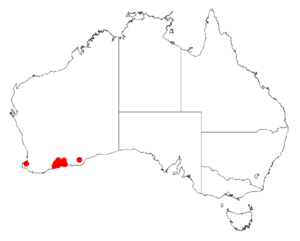Acacia ingrata facts for kids
Quick facts for kids Acacia ingrata |
|
|---|---|
| Scientific classification | |
| Genus: |
Acacia
|
| Species: |
ingrata
|
 |
|
| Occurrence data from AVH | |
Acacia ingrata is a type of shrub, which is a small, bushy plant. It belongs to a large group of plants called Acacias, also known as wattles. This particular acacia is special because it only grows in the southwestern part of Australia. When a plant or animal only lives in one specific area, it's called endemic.
About This Shrub
The Acacia ingrata is a shrub that spreads out and has many stems. It usually grows to be about 0.15 to 0.5 metres (0.5 to 1.6 ft) tall. Its branches are light grey and can be smooth (called glabrous) or have a few hairs. You might notice small, tooth-like bumps on its branches where tiny leaf-like parts, called stipules, used to be.
The leaves of this plant are quite unique. They are actually flattened leaf stalks called phyllodes. These phyllodes are green and shaped like a narrow triangle or rectangle. They are about 6.5 to 20 mm (0.26 to 0.79 in) long and 1 to 2 mm (0.039 to 0.079 in) wide. They don't have a clear central vein.
Flowers and Seeds
Acacia ingrata produces pretty cream-white flowers. You can see these flowers from September to January. The flowers grow in small clusters, called inflorescences, which look like one or two small balls on a short stem. Each flower cluster has about five to seven cream to white flowers.
After the flowers, the plant grows seed pods. These pods look a bit like a string of beads. They can be up to 5 cm (2.0 in) long and 4 to 5 mm (0.16 to 0.20 in) wide. Inside these pods are dull, dark brown seeds. The seeds are shaped like an oval and are about 4 to 6 mm (0.16 to 0.24 in) long.
Where It Grows
This wattle plant is found naturally along the coast in the South West and Goldfields-Esperance regions of Western Australia. It likes to grow in gravelly clay-loam and sandy soils that come from a type of rock called laterite.
Most of these plants are found on the south coast. They grow between Mid Mount Barren (near Ravensthorpe) in the west and Young River in the east. There is also a separate group of these plants found on the west coast, around the town of Busselton.

